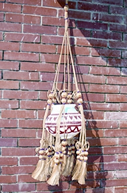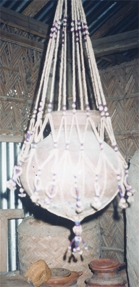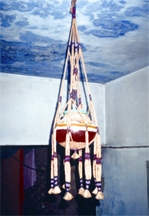Nakshi Shika
Nakshi Shika embroidered reticulate bag made of jute strings featuring folk art motifs. It is usually made of jute. Shikas are found in almost every house of the rural areas of Bangladesh. This shika is fastened with the beam or ceiling of the house and different things of the family, including food stuff, are kept hanging there. The women are the makers of this form of art.
Though shika is made for domestic uses, skills in art and the sense of beauty of the artisan find expression through it. Embroidery is done on the shika with the help of glass-beads, cowries (shells used as a coin of the smallest denomination), round clods etc. Its diversity of joints and decoration processes are subjects of novelty. Different types of knots are used in making a shika, eg Maura knot, Rasun knot, Pagdi knot, Daman knot, Taha (Taka) knot, Badshi knot, Jhunti knot, Supari knot etc. The decoration that are added with these are siki (a quarter), Taka, Hatir Kan (ear of the elephant), Dalim etc. In some shikas, decoration of Astadal Padma and Kadam Phul are also seen.
 |
 |
 |
| Nakshi Shakia (Dhaka) | Nakshi Shika (Mymensingh) | Nakshi Shika (Rajshahi) |
The nakshi shika has different local names, eg jilapi, Amirti, Aulakeshi, Kauyar Thyang, Ichar Thyang, Jali, Bedi, Kautar Khopi etc. The shika has different names according to the style of making. Thus the shika hanged at two ends of a bamboo slip is named, 'Bhar' or 'Bak'. The shika made for keeping Kantha (quilt) and pillows is known as Gainja, Panjab, Fulchanga (or Fultangi) etc. Fulchanga shika is made by knitting lahar or Jali (nets) at four corners or wheels of a bamboo and on it books, the holy quran, caps etc are kept. For keeping the quilts and pillows, a type of shika called jot made in braided hair net with four tiers, are also used. The shika used for hanging a large number of pots together is called the Hazari (thousand) shika. Moreover, there is a type of shika known as Hat (seven) shika, in which seven shikas are closely linked with one another. In it braided jute is twisted to make space for keeping small pots. It is found in Bera of Pabna district.
In the past shikas were made within the family and its purchase and sale was not so noticeable. At present, with increasing demand as well as appreciation of handicrafts these are being commercially made and have also got good foreign markets. Now the houses of city dwellers are often decorated with nakhshi shika. [Momen Chowdhury]
